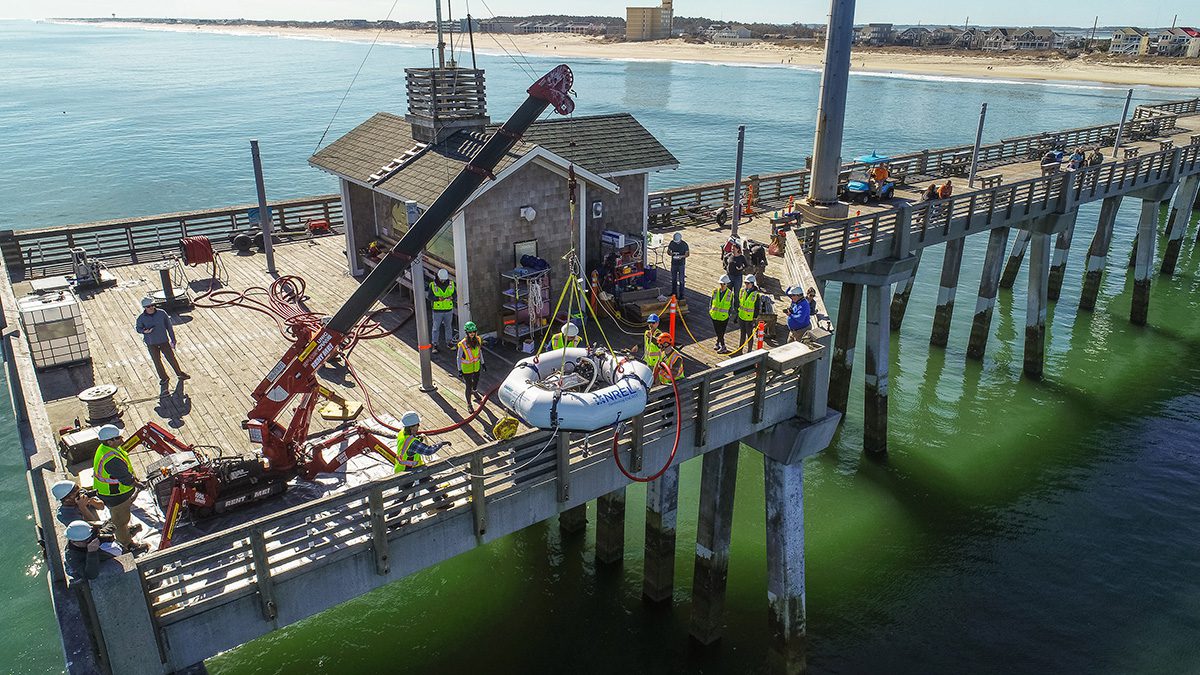
NAGS HEAD — Imagine that a hurricane skirted the coast, causing the power to go out. You wait for the green light to blink on your backup power. Getting the all-clear, you flip on the switch connected to the community’s wave-powered alternate generator, and your refrigerator is humming again.
That creative concept is still a distant fantasy in 2024, but it’s the kind of need-inspired brainstorming that a new $3.6 million National Science Foundation community-oriented wave energy project encourages. Launched on Sept. 27, scientists at the Coastal Studies Institute on the East Carolina University Outer Banks Campus in Wanchese will be seeking input from folks around Nags Head to use toward developing and deploying practical wave-energy technology on the Outer Banks before the end of the five-year project.
Supporter Spotlight
“The goal is to present two or three potential technologies and get (community) inputs to really see whether or not this meets their need,” Eric Wade, assistant professor in the Department of Coastal Studies at East Carolina University, which includes the CSI campus, told Coastal Review recently.
Researchers from ECU will partner with the University of Michigan, University of North Carolina Chapel Hill and Virginia Tech on the project, with focal communities chosen in Michigan at Beaver Island and in North Carolina at Nags Head.
While Wade said it’s not yet likely that alternate sources of energy could be produced in Nags Head, other marine energy could be more conceivable for the Outer Banks at this stage. Some examples he cited were use in desalination, powering autonomous underwater vehicles and marine aquaculture.
“The introduction of this technology will not lower the electricity bill,” he said. “It will not have this massive transformation. It may be at a very small scale.”
In a substantive way, the new National Science Foundation project builds on two ongoing research projects that CSI is part of: the NC Renewable Ocean Energy Program and the Atlantic Marine Energy Center. The important difference, Wade explained, is that the main objective of the new project is to converge different components of the community — engineering, sociological and environmental — so they can “speak” with each other.
Supporter Spotlight
“The local context will drive the extent, and in my opinion, will drive the feasibility of convergence, because we need to be able to design technologies that meet the needs of communities,” he said.
“And so, what this project is trying to do is see how can we get them to be on the same page, to be able to move marine energy, and specifically wave energy, forward,” Wade said.
Each of the components communicate in different “languages” and have different requirements for their disciplines, he added. “The difficulty and what is unique for this project is that bringing those together requires a lot of work and a lot of intentional talk.”
Wade said the goal in the next two years is to have community sessions that will bring together representatives from different sectors of the communities to share their perspectives and priorities.
“We’ll then take all of that information, go back to the community, consolidate, do some analysis,” he said.
The building and deployment work on the selected technology will be done for remaining three years. The big picture, ultimately, is all part of the what marine energy scientists call “powering the blue economy.”
The blue economy is broadly defined as economic activity driven by or based on the world’s oceans. And as Wade noted, the U.S. is hustling to catch up with the more advanced blue technology of Europe.

Lindsay Dubbs, a UNC research associate professor based at the institute, is collaborating with Wade on the project. She is focused on environmental and ecological assessments. That work, she said, involves devising frameworks for analyzing environmental impacts of potential marine energy developments, as well as best practices for reducing negative impacts.
Dubbs, who also serves as associate director of the NC Renewable Ocean Energy Program and the Atlantic Marine Energy Center, said their project team includes student researchers, as well as colleagues from Virginia and Michigan.
“We’re also communicating a good deal with communities in Alaska who are already implementing wave energy technologies in their communities,” she said. “We have this community advisory group that is comprised of people from all of those different communities, and the two study sites that we’re focusing this convergent research on are Beaver Island and Nags Head.”
Waves on the Outer Banks are powerful, but they’re not as big as waves on the West Coast, Dubbs said. That’s mainly because of differences in the water depths approaching the coasts. “The power density of the wave resource — how much energy can be harnessed — within an area on the West Coast is much greater.”
But, she countered, a large area of the North Carolina coast has untapped wave energy resources that could at least provide energy for niche markets. And that could include backup power. But on the East Coast and the Outer Banks, generation would be more likely occur at a community scale, not at utility scale like on the West Coast.
The project team is just starting conversations with the community groups to understand their perspectives, wants and needs for a wave-energy source, Dubbs said. But rather than advocate for a particular technology, the team’s intent is to help the community decide on the type of technology that meets their needs. Part of that process has to consider trade-offs, she said, and whether it’s worth harnessing the available energy, and if it can be done “in a manner that our community supports” that poses the least environmental risk.
“It’s so abstract and theoretical that it’s sometimes hard to really imagine what’s possible,” she said. “The exciting thing about wave energy right now, is just about everything is being imagined. But as far as coming to convergence on something that will make it more economically viable and less abstract — that’s difficult.”








